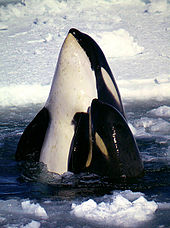
Orcas or killer whales have a cosmopolitan distribution and several distinct populations or types have been documented or suggested. Three to five types of orcas may be distinct enough to be considered different races,[1] subspecies, or possibly even species[2] (see Species problem). The IUCN reported in 2008, "The taxonomy of this genus is clearly in need of review, and it is likely that O. orca will be split into a number of different species or at least subspecies over the next few years."[3] Although large variation in the ecological distinctiveness of different orca groups complicate simple differentiation into types.[4] Mammal-eating orcas in different regions were long thought likely to be closely related, but genetic testing has refuted this hypothesis.[5]
- ^ Baird 1999, p. 1.
- ^ Cite error: The named reference
Pitman2003was invoked but never defined (see the help page). - ^ Reeves, R.; Pitman, R.L.; Ford, J.K.B. (2017). "Orcinus orca". IUCN Red List of Threatened Species. 2017: e.T15421A50368125. doi:10.2305/IUCN.UK.2017-3.RLTS.T15421A50368125.en. Retrieved 19 November 2021.
- ^ De Bruyn, P. J. N.; Tosh, C. A.; Terauds, A. (2013). "Killer whale ecotypes: Is there a global model?". Biological Reviews. 88 (1): 62–80. doi:10.1111/j.1469-185X.2012.00239.x. hdl:2263/21531. PMID 22882545. S2CID 6336624.
- ^ Schrope, Mark (2007). "Food chains: Killer in the kelp". Nature. 445 (7129): 703–705. Bibcode:2007Natur.445..703S. doi:10.1038/445703a. PMID 17301765. S2CID 4421362.
© MMXXIII Rich X Search. We shall prevail. All rights reserved. Rich X Search
